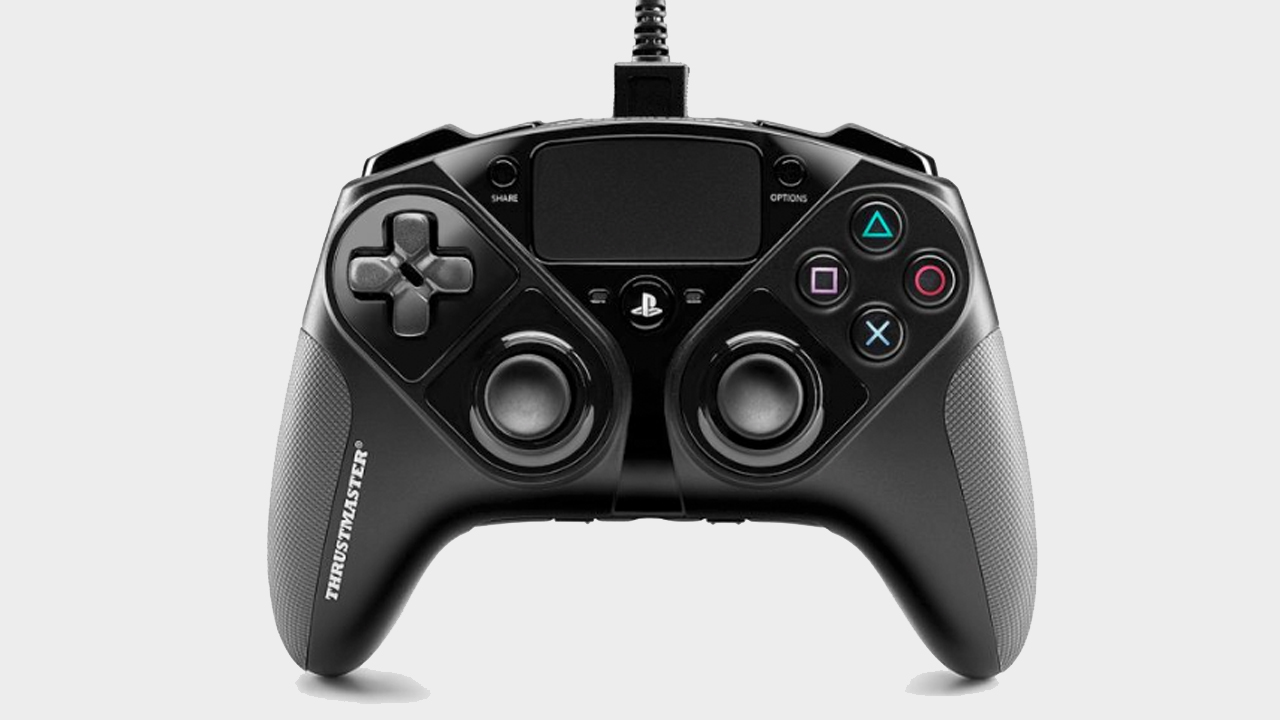GamesRadar+ Verdict
A highly customisable controller with excellent, tactile feedback. Sadly, it lacks features that would make it essential, and comes at a very high a price.
Pros
- +
Swapping modules is fast and easy
- +
Feels weighty, akin to an Xbox One pad
- +
Button presses are clicky and mechanical
Cons
- -
Considerably more expensive than competing products
- -
Back buttons are too small and sensitive
- -
Aesthetic design isn’t very appealing
Why you can trust GamesRadar+
When it comes to gaming peripherals like joysticks and steering wheels, Thrustmaster is a household name. Controllers on the other hand, are much less the company’s thing, with only a few products released during the PS3 and Xbox 360 era. The Thrustmaster eSwap Pro Controller is its first attempt at entering the competitive gaming market, which is saturated with products from the likes of Scuf and Nacon, so can it provide a viable alternative for esports amateurs and pros across a variety of genres and represent good value for money? Our hopes were high, especially given that Sony has granted this ‘officially licensed’ status, and Thrustmaster does make some of the best racing steering wheels around.
Thrustmaster eSwap Pro controller - Design
The second you take the Thrustmaster eSwap Pro Controller out of the box, two things become apparent; aesthetic design isn’t what it’s going for and, if you have small hands, this controller may not be comfortable. While some pads focus on looking the part like the Nacon Revolution Unlimited with its rubberised faceplate and ring of light around the analog sticks, the eSwap Pro is a bulky device with sections that stand out like a sore thumb.
No matter which console you play on, everyone has a preference for either the smaller symmetrical design of the Dualshock 4, or the asymmetrical bulk of the Xbox One controller. This pad is for those who play on PS4 but much prefer the weight and size of an Xbox One controller, because it’s visibly inspired by Microsoft’s design much more than Sony’s, from the shoulder buttons and triggers to the d-pad and sticks.

Thrustmaster eSwap Pro controller - Features
Calling this device the "eSwap" Pro Controller isn’t just an arbitrary name in an attempt to sound hip and trendy; the main selling point for the pad is the ability to swap out different modules on the controller, for either aesthetic or functional reasons. Don’t like the analog sticks being symmetrical with a concave design? You can simply pull them out and unscrew them, then replace the sticks with some convex ones included in the box and switch the location of the left stick with the d-pad, to resemble an Xbox One pad. Fingers slipping off the triggers? Use the screwdriver found in the box to install some extended ones instead.
It wouldn’t be a competitive controller without the implementation of extra buttons too, found in the usual place on the back of the pad. It’s a common inclusion and much needed feature that ensures players don’t have to take their thumbs off of the right analog stick in order to hit any of the four face buttons (X, Circle, Square, Triangle - same as the PS4 controller). Most of the time however, you’ll find paddles on the back as they’re bigger and easier to distinguish between mid-game. The buttons found here are a welcome inclusion, but require a much softer press and, as such, you can often find yourself accidentally pushing them which leads me to wonder why buttons were used over paddles.

Thrustmaster eSwap Pro controller - Performance
As someone who hasn’t consistently used a controller with back buttons/paddles for a few years, retraining my brain to use the four buttons on the back took some work. Eventually it all started to click, but since they’re small buttons and not paddles, they often felt too close together and easy to accidentally push.
To find your optimal set-up, you’ll probably need to fiddle around for a while with the modules. Eventually I settled on using convex analog sticks in the standard symmetrical formation, and also switched out the triggers for the longer ones because they felt too short otherwise. It’s worth noting that I don’t have particularly big hands, so after some lengthy FUT Champions matches on FIFA 20 and ranked mode games in Apex Legends, my hands started to ache, specifically my thumbs when reaching to push the thumbsticks.
Until that point, it’s tough to say whether my performance improved in-game. My shots felt more on point in Apex thanks to the convex, slightly taller sticks compared to a usual DualShock 4, but in FIFA, the controller was much less useful. It’s also completely impossible to use the eSwap Pro wirelessly, meaning you have to be constantly connected via the braided USB cable. Great to minimise input lag, bad for anyone that may want to play casually on the sofa with the controller too. Given the high price of £149, and level of customisation here, it seems odd that the option for wireless play (during non-competitive gaming sessions) isn’t included.
Every button press, aside from the rear buttons, has a satisfying mechanical click to it. There’s no ambiguity that leaves you wondering if you actually pressed the button and the game you’re playing didn’t recognise it thanks to input lag or anything along those lines; with this, you’re sure every time. It’s worth noting that while this controller can be used on PC too - and further customised with some in-depth Thrustmapper software - at the time of writing, it’s not available for download. This software allows you to adjust things like vibration, button mapping, sensitivity and other granular details required for truly competitive play.

Overall - Should you buy it?
The ability to switch out different components is brilliant - you can even play with three analog sticks if you like - but you’ll quickly settle on one configuration, which means the unique selling point of the controller becomes redundant fairly soon. It’s a great controller, but so is the basic DualShock 4, so when companies like Scuf provide the same level of customisation and extra features on that base model, the eSwap Pro becomes a hard sell, especially at £149.
There is no US release currently scheduled.
Give me a game and I will write every "how to" I possibly can or die trying. When I'm not knee-deep in a game to write guides on, you'll find me hurtling round the track in F1, flinging balls on my phone in Pokemon Go, pretending to know what I'm doing in Football Manager, or clicking on heads in Valorant.




